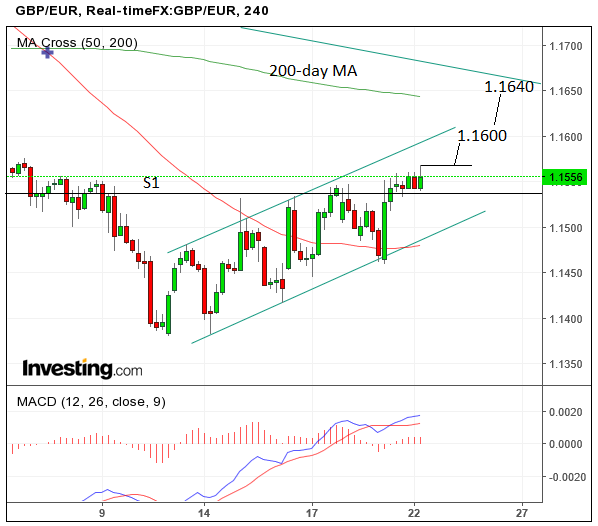Pound to Continue Edging Higher Against Euro Near-Term

The British Pound to Euro exchange rate has been in the ascendency since mid-March when lows towards 1.14 were rejected and bargain-hunters stepped into the market to pick up a discounted Pound.
The market has since risen back above 1.5 and those with an interest in the market are keen to know whether we are at the start of a run back towards February highs around 1.19.
It is too early to answer this question, but the short-term outlook remains favourable to Sterling we believe.
The GBP/EUR exchange rate has established a mini up-trend on the four-hour chart and we believe this signifies the potential for further gains over the next couple of days.
The advance is likely to continue given the underpinning support from the S1 monthly pivot at 1.1540 which is unlikely to break very easily.
Monthly pivots are significant support and resistance levels based on previous monthly highs and lows and are used by traders to assess the trend.

We see more upside as the path of least resistance for the pair, which should move up to the top of the rising channel at around 1.1600 next.
Although there is likely to be a pull-back at that level the pair is then forecast to continue higher to the next target at the 200-day moving average (MA) at 1.1650, as price action often stalls at major moving averages which provide dynamic levels of support and resistance.
On the data front, the Euro has recently lost some ground this morning after Balance of Payments data from the European Central Bank showed the region's Current Account surplus shrank more-than-expected in February to €24b, much lower than the 30bn in January.
Markets had forecast a surplis of €28bn.
Looking ahead, the main release for the single currency comes towards the end of the week in the form of PMI data for Manufacturing and Services in March.
This is released on Friday morning at 9.00 GMT. Although consensus estimates are for a marginal slowdown in growth, the opposite would be very bullish for the Euro.
Data Ahead for the Pound
The Pound has had a strong first half of the week after rising on the back of unexpectedly high inflation data, which suggests a greater probability of the Bank of England (BOE) raising interest rates, and higher interest rates tend to boost a currency as it attracts more foreign capital inflows.
Whether Sterling’s rally will last is debatable as many analysts have expressed scepticism that the BOE will react to the higher inflation by putting up rates because it is not grounded in increased economic growth but rather the effect of the weak pound.
To put up rates whilst growth remains so subdued could harm the economy by increasing borrowing costs and detracting from investment.
As such, the Sterling trade may be short-lived.
Thursday is still a big day for the Pound from a data perspective, with Retail Sales released at 9.30 GMT expected to rise 2.6% year-on-year and 0.4% month-on-month and Core Retail Sales by 3.1% year-on-year and 0.4% month-on-month.
Retail Sales has been a poor performer of late due to rising shop prices from weak-pound induced inflation on imported products.
If there is yet another decline it will start ringing alarm bells for the economy and spell weakness for the Pound.
BOE’s Broadbent will also speak on Thursday, at 9.15, so we might get the first response from the BOE since the overwhelming inflation data.





